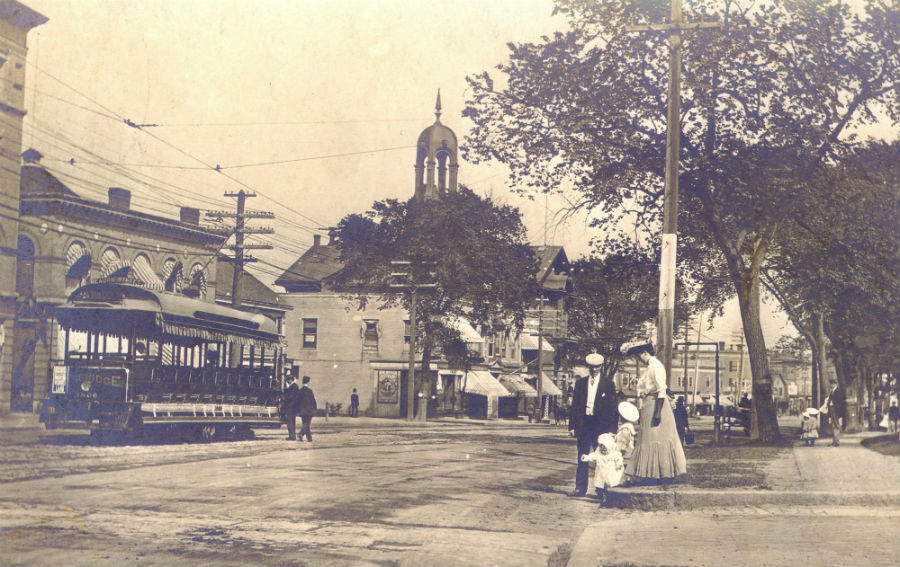Longtime Society member Bill Mahoney, who recently donated this previously unpublished image to our collection, would often remark “If only the photographer would have directed his lens just a little bit more . . .” towards a particular direction, we’d have a vastly easier time zeroing-in on a date for many historical photographs.
Such is the case with this beautiful summer scene. At the far left we see just the eastern edge of the original four-story Associate’s Block (built 1902). If we could see its complete façade, the presence or absence of its 1907 single-story addition would be a useful landmark. But there are many other details that suggest this image dates to approximately 1905.
Notice the family group who appear to be waiting for a streetcar (whose stops were indicated by the high painted band on a utility pole), this one at the corner of Massachusetts Avenue and Library Way (today’s Peg Spengler Way, and still a public transportation stop for MBTA buses). The lady’s long skirt is perfectly modest, but with a hemline practical to qualify it as a good “walking costume” consisting of a tucked shirtwaist and circular skirt (in a self-flounce pleated pattern). The shirtwaist sleeves are cuffed and met by elbow-length gloves, the latter an indispensable article of clothing whenever a lady of the era left her home, at any time of year. The little boy in front of her is stylishly attired in a sailor’s suit.
Looking carefully at the row of shade trees in the background, we see bands of burlap attached to their trunks. These were a preventive measure to inhibit gypsy moth caterpillars from ascending to feed on the leaves. In 1904, the trees from the Belmont line to the Mystic Lakes had been denuded, so efforts in this later year seem to have been successful.
Across the street, a ten-bench open trolley car, bearing number 1906, arrived on the Boston Elevated line originating in Kendall Square in Cambridge, via Beacon Street in Somerville. The streetcar route system was so extensive that many such “one-seat rides” are envied by public transportation commuters today. The trolley car stands empty, likely awaiting a switch to eastbound tracks, because its route terminated at Arlington Center, rather than Arlington Heights.
Partly hidden behind the streetcar is the Studio Building, so-named because its principal tenant was Litchfield’s photography rooms and laboratory. The exterior was completely remodeled in the 1920s for the Menotomy Trust Company, then again to its present appearance in 1948 when acquired by Harvard Trust Company. Today it is a Bank of America branch.
Beyond Railroad Avenue (today’s David Lamson Way) is the Sherburne Block, known informally as the “post office block” after its anchor tenant. Other businesses included Ronco’s barbershop (note the striped barber pole curbside). That there is no flag flying above the U.S. Post Office entrance on a fine day, we can safely assume that this image was made on a Sunday afternoon. Another clue that it is Sunday is the presence of men along with the women and children, because Saturdays were at least partial workdays for most.
Crowning the entire scene is the jaunty cupola and open lantern of the Arlington Town Hall, completed in 1853 and replaced by the present town hall in 1913. The building had long ceased to function efficiently as the center for municipal government. Functional obsolescence aside, its architectural style was considered decidedly “old hat.” The cupola would vanish from the Arlington skyline in 1923 after being struck by lightning, but the building, thus shorn and increasingly forlorn, would house a variety of businesses (including a taxi company waiting room in its final days) until it was razed in 1960 for the present alignment of Mystic Street. Perhaps it’s time for a commemorative plaque to Arlington’s first town hall in the “Uncle Sam Park” that occupies part of its former footprint today.



Leave a Reply